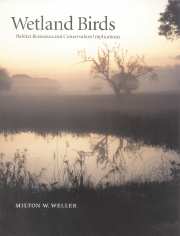Book contents
- Frontmatter
- Contents
- List of plates
- Preface
- Acknowledgments
- 1 Introduction
- 2 Wetlands: what, where, and why
- 3 Major groups of birds that use wetlands
- 4 Water and other resource influences
- 5 Foods, feeding tactics, strategies, and guilds
- 6 Bird mobility and wetland predictability
- 7 Other behavioral and physical influences on wetland living
- 8 Spatial and structural patterns
- 9 Habitat dynamics: water, plant succession, and time
- 10 Population consequences of wetland abundance and quality
- 11 How birds influence wetlands
- 12 Conservation implications
- 13 Measures of bird habitat use and quality
- 14 Current status and some conservation problems
- 15 Conservation and management strategies
- 16 Outlook
- 17 Epilogue
- Appendix 1 Scientific names of birds and bird groups
- Appendix 2 Scientific names of animals and animal groups other than birds
- Appendix 3 Scientific names of plants and plant groups
- Index of birds and bird groups
- Subject index
15 - Conservation and management strategies
Published online by Cambridge University Press: 02 October 2009
- Frontmatter
- Contents
- List of plates
- Preface
- Acknowledgments
- 1 Introduction
- 2 Wetlands: what, where, and why
- 3 Major groups of birds that use wetlands
- 4 Water and other resource influences
- 5 Foods, feeding tactics, strategies, and guilds
- 6 Bird mobility and wetland predictability
- 7 Other behavioral and physical influences on wetland living
- 8 Spatial and structural patterns
- 9 Habitat dynamics: water, plant succession, and time
- 10 Population consequences of wetland abundance and quality
- 11 How birds influence wetlands
- 12 Conservation implications
- 13 Measures of bird habitat use and quality
- 14 Current status and some conservation problems
- 15 Conservation and management strategies
- 16 Outlook
- 17 Epilogue
- Appendix 1 Scientific names of birds and bird groups
- Appendix 2 Scientific names of animals and animal groups other than birds
- Appendix 3 Scientific names of plants and plant groups
- Index of birds and bird groups
- Subject index
Summary
The existing problems that wetland birds face and the potential applications of ecological data must be considered in the light of current structure and approaches in wildlife conservation. Historically, conservation and management efforts have focused on legal protection, habitat management, population management, and human dimensions, and all must be used concurrently to be effective. Our focus here is habitat management, which has been used for different purposes but is often aimed at species management when, at least for wetlands, most management influences the entire community.
Early efforts of habitat preservation in the USA, and probably in most countries, focused on wetland habitat protection. Direct purchase for refuges, sanctuaries, and preserves has been common, but leasing and legally binding conservation easements and agreements have been more common recently as a means of controlling more areas at lower cost per unit area, especially when multiple ownership is involved. Protection of small basins or patches of habitat has worked well for wetlands because many birds are habitat-island species that use several habitat units and fly between them. In the USA, there are over 500 National Wildlife Refuges operated by the US Fish and Wildlife Service involving over 92 million acres, most of which include major wetlands (Riley and Riley 1992). Other federal agencies such as the Forest Service and Bureau of Land Management also hold title to and manage similar areas, and the Natural Resource Conservation Service program accomplishes similar protection on private lands through the Soil Conservation Reserve Program (Johnson and Igl 1995). Many states, counties and cities have protected additional and generally smaller but no-less valuable areas through refuges, public hunting areas, nature centers, and green belts.
- Type
- Chapter
- Information
- Wetland BirdsHabitat Resources and Conservation Implications, pp. 227 - 238Publisher: Cambridge University PressPrint publication year: 1999



